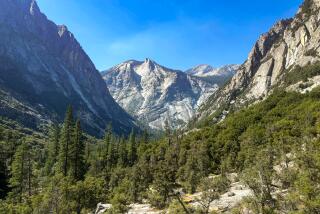Anasazi Vanished From Colorado 600 Years Ago : Archeologists Dig Into Mystery of Lost Tribe
- Share via
CORTEZ, Colo. — Here in the southwest corner of Colorado, schoolchildren and other amateurs are digging alongside archeologists for clues to the mystery of the Anasazi people, who disappeared from the region more than 600 years ago.
Stuart Struever, a self-styled archeologist-entrepreneur and founder of the Crow Canyon Archeological Center, calls the operation a kind of “intellectual Outward Bound,” alluding to the wilderness program that challenges people to test their physical limits.
About 1,300 people came to Crow Canyon in 1987 to get their hands into the dirt, among them retirees from New York, grade-school pupils from Chicago, teen-agers from a nearby Zuni reservation and Soviet exchange students. Several hundred others have attended the center’s seminars on Southwestern archeology.
Under the supervision of trained researchers, the amateurs are excavating the ruins of the Anasazi, the “ancient ones” in the language of some of their apparent descendants, the Navajo.
Civilization Disappeared
The Anasazi lived in what is now called the Four Corners region from about 500 BC until their sudden disappearance from much of the region about AD 1300, archeologists say.
Money for Crow Canyon’s research and six full-time researchers comes from student fees and contributions from individuals and corporations.
The center also has programs designed to teach children from Cortez and nearby reservations about the Anasazi.
Ian Thompson, a local historian who is director of the Crow Canyon Center, said it has helped to raise awareness of the Anasazi, and he hopes it will curb some of the random pottery-hunting that is destroying much of what the Anasazi left behind.
Site Near Mesa Verde
Crow Canyon lies on the relatively fertile McElmo Plateau (elevation 6,900 feet) in the shadow of Mesa Verde, where some of the best-known Anasazi cliff dwellings were uncovered early in this century.
The Crow Canyon campus, just outside Cortez, has research laboratories, conference rooms, the beginnings of a library, artifact-filled sandboxes for children under 11, a cafeteria and dormitories that can house up to 100 people. The dorms are shaped like traditional Indian hogans.
A short drive away, around several shallow canyons, are the excavation sites. A survey begun about five years ago found 454 locations of Anasazi ruins within a 1 1/2-mile circle, roughly between the campus and Sand Canyon, the main excavation site.
In this area, topsoil accumulates very slowly, so it is easy to spot the remains of centuries-old Anasazi walls, circles of rocks in farmers’ fields.
Aside from the dig at Sand Canyon, a handful of other sites are being explored.
Plateau Rich in Ruins
Bruce Bradley, director of the Sand Canyon excavation, said the McElmo Plateau is rich in Anasazi ruins but has not been explored much because archeologists have concentrated more on Mesa Verde and other sites.
Bradley hopes to learn more about the last days of the Anasazi and perhaps find out what happened to them.
One day recently, about a dozen adult volunteers were digging under the sun at one of the test sites near Sand Canyon. Among them were David and Bernice Gotlieb, a retired couple from New York.
“We’ve been armchair archeologists--voyeurs--but this is our first time with our hands in it,” said David Gotlieb, 64, as he rubbed a fistful of soil through a screen to sift out any pottery shards or other vestiges of early habitation.
Digging, he says, gives him “a sense of history, and the curiosity that goes with it.”
The Gotliebs, who uncovered some ancient postholes in their area the day before, said they planned to come back to dig every year.
Their supervisor, Mark Varien, said he enjoys working with lay people.
Pro-Amateur Alliance
Varien, who wears a cowboy hat with a beaded band, came to Crow Canyon after two years as archeologist for the Zuni.
“Archeology is not this elitist thing that only archeologists can do,” he said. “Cultural resources are our heritage, and people should be able to participate in that.”
This is not Struever’s first experiment in combining research with public education. As director of the Center for American Archaeology and an archeology professor at Northwestern University in his native Illinois, he directed the huge Koster excavation at Kampsville, which drew thousands of students and lay archeologists in the 1970s.
Struever’s introduction to the Southwest came when he moved to Telluride in 1976 to write a book about the Koster dig. He said he quickly became a convert to Anasazi archeology and the whole “magical” region.
He wants Crow Canyon to be a prototype for future projects.
Struever went first for support to Ray Duncan, a Denver-based oilman who is principal stockholder in the Purgatory Ski Area near Durango and who grew up with Struever in Peru, Ill.
Financial Backer Found
Duncan became Crow Canyon’s principal benefactor and now is chairman of the board of directors.
Thompson says the nonprofit Crow Canyon had a $1.2-million budget this year, about 85% of it from tuition.
“It’s working its way toward self-sufficiency,” he said.
The center also won a National Science Foundation grant for $62,000 to be used for research.
Last year it cost $645 for an adult digger to spend a week at Crow Canyon. For schoolchildren it usually costs about $60 a day, but children of the poor Cortez area can join the dig for just $2 a day.
The center also has a $6,000 scholarship fund for Indian students who want to come dig.
“We’re trying to elevate the public consciousness here. We want them to know about their own area,” Struever said.
More to Read
Sign up for Essential California
The most important California stories and recommendations in your inbox every morning.
You may occasionally receive promotional content from the Los Angeles Times.










